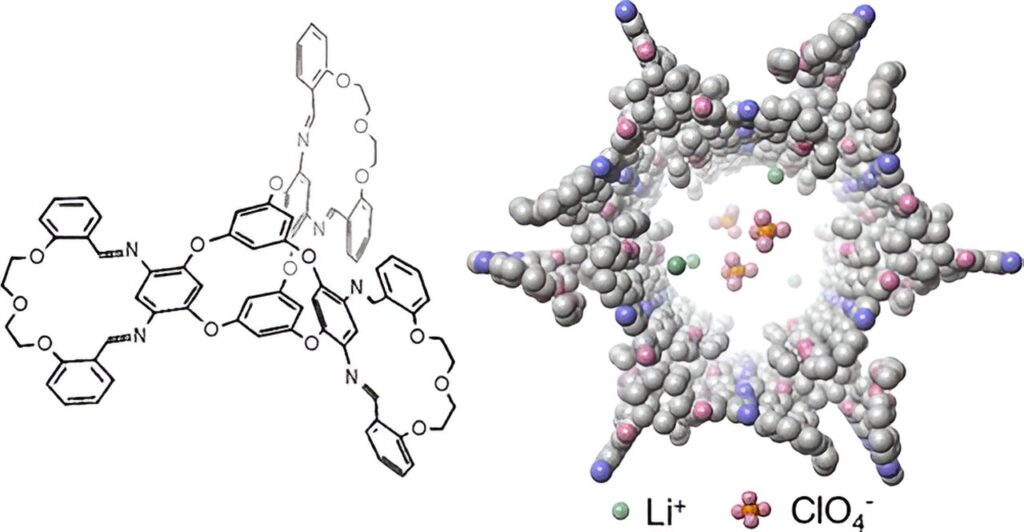By fusing together a pair of contorted molecular structures, Cornell researchers have created a porous crystal that can uptake lithium-ion electrolytes and transport them smoothly via one-dimensional nanochannels—a design that could lead to safer solid-state lithium-ion batteries.
The team’s paper, “Supramolecular Assembly of Fused Macrocycle-Cage Molecules for Fast Lithium-Ion Transport,” is published in the Journal of the American Chemical Society. The lead author is Yuzhe Wang.
The project was led by Yu Zhong, assistant professor of materials science and engineering at Cornell Engineering and the paper’s senior author, whose lab specializes in synthesizing soft and nanoscale materials that can advance energy storage and sustainability technologies.
Zhong had just joined Cornell’s faculty two years ago when he was contacted by Wang, an undergraduate transfer student beginning his junior year, who was enthusiastic about taking on a research project.
At the top of Zhong’s list of potential topics was finding a way to make a safer lithium-ion battery. In conventional lithium-ion batteries, the ions are shuttled along via liquid electrolytes. But liquid electrolytes can form spiky dendrites between the battery’s anode and cathode, which short out the battery, or in rare cases, explode.
A solid-state battery would be safer, but that comes with its own challenges. Ions move slower through solids, because they face more resistance. Zhong wanted to design a new crystal that was porous enough that ions could move through some kind of pathway. That pathway would need to be smooth, with weak interactions between the lithium ions and the crystal, so the ions wouldn’t stick. And the crystal would need to hold enough ions to ensure a high ion concentration.
Wang went to work and devised a method of fusing together two eccentric molecular structures that have complementary shapes: macrocycles and molecular cages. Macrocycles are molecules with rings of 12 or more atoms, and molecular cages are multi-ringed compounds that more or less resemble their name.
“Both macrocycles and molecular cages have intrinsic pores where ions can sit and pass through,” Wang said. “By using them as the building blocks for porous crystals, the crystal would have large spaces to store ions and interconnected channels for ions to transport.”
Wang fused the components together, with a molecular cage at the center and three macrocycles radially attached, like wings or arms. These macrocycle-cage molecules use hydrogen bonds and their interlocking shapes to self-assemble into larger, more complicated, three-dimensional crystals that are nanoporous, with one-dimensional channels—”the ideal pathway for the ion to transport,” according to Zhong—that achieve ionic conductivity of up to 8.3 × 10-4 siemens per centimeter.
“That conductivity is the record high for these molecule-based, solid-state lithium-ion-conducting electrolytes,” Zhong said.
Once the researchers had their crystal, they needed to better understand its makeup, so they collaborated with Judy Cha, Ph.D., professor of materials science and engineering, who used scanning transmission electron microscopy to explore its structure, and Jingjie Yeo, assistant professor of mechanical and aerospace engineering, whose simulations clarified the interactions between the molecules and lithium ions.
“So, with all the pieces together, we eventually established a good understanding of why this structure is really good for ion transport, and why we get such a high conductivity with this material,” Zhong said.
In addition to making safer lithium-ion batteries, the material could also be potentially used to separate ions and molecules in water purification and to make mixed ion-electron-conducting structures for bioelectronic circuits and sensors.
“This macrocycle-cage molecule is definitely something new in this community,” Zhong said. “The molecular cage and macrocycle have been known for a while, but how you can really leverage the unique geometry of these two molecules to guide the self-assembly of new, more complicated structures is kind of an unexplored area.
“Now in our group, we are working on the synthesis of different molecules, how we can assemble them and make a molecule with a different geometry, so we can expand all the possibilities to make new nanoporous materials. Maybe it’s for lithium-ion conductivity or maybe for even many other different applications.”
Co-authors include doctoral student Kaiyang Wang; master’s student Ashutosh Garudapalli; postdoctoral researchers Stephen Funni and Qiyi Fang; and researchers from Rice University, University of Chicago and Columbia University.


